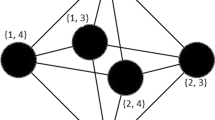Abstract
This work studies the question of quantified derandomization, which was introduced by Goldreich and Wigderson (STOC 2014). The generic quantified derandomization problem is the following: For a circuit class \({\mathcal{C}}\) and a parameter B=B(n), given a circuit \({C\in\mathcal{C}}\) with n input bits, decide whether C rejects all of its inputs, or accepts all but B(n) of its inputs. In the current work, we consider three settings for this question. In each setting, we bring closer the parameter setting for which we can unconditionally construct relatively fast quantified derandomization algorithms, and the “threshold” values (for the parameters) for which any quantified derandomization algorithm implies a similar algorithm for standard derandomization.
For constant-depth circuits, we construct an algorithm for quantified derandomization that works for a parameter B(n) that is only slightly smaller than a “threshold” parameter and is significantly faster than the best currently known algorithms for standard derandomization. On the way to this result, we establish a new derandomization of the switching lemma, which significantly improves on previous results when the width of the formula is small. For constant-depth circuits with parity gates, we lower a “threshold” of Goldreich and Wigderson from depth five to depth four and construct algorithms for quantified derandomization of a remaining type of layered depth-3 circuit that they left as an open problem. We also consider the question of constructing hitting-set generators for multivariate polynomials over large fields that vanish rarely and prove two lower bounds on the seed length of such generators.
Several of our proofs rely on an interesting technique, which we call the randomized tests technique. Intuitively, a standard technique to deterministically find a “good” object is to construct a simple deterministic test that decides the set of good objects, and then “fool” that test using a pseudorandom generator. We show that a similar approach works also if the simple deterministic test is replaced with a distribution over simple tests, and demonstrate the benefits in using a distribution instead of a single test.
Similar content being viewed by others
References
M. Bellare, & J. Rompel (1994). Randomness-efficient Oblivious Sampling. In Proc. 35th Annual IEEE Symposium on Foundations of Computer Science (FOCS), 276–287.
Eli Ben-Sasson, Oded Goldreich, Prahladh Harsha, Madhu Sudan, Salil Vadhan (2006) Robust PCPs of proximity, shorter PCPs and applications to coding. SIAM Journal of Computing 36(4): 889–974
Andrej Bogdanov (2005). Pseudorandom generators for low degree polynomials. In Proc. 37th Annual ACM Symposium on Theory of Computing (STOC), 21–30.
Andrej Bogdanov, Emanuele Viola (2010) Pseudorandom bits for polynomials. SIAM Journal of Computing 39(6): 2464–2486
Shiva Chaudhuri & Jaikumar Radhakrishnan (1996). Deterministic Restrictions in Circuit Complexity. In Proc. 28th Annual ACM Symposium on Theory of Computing (STOC), 30–36.
Kuan Cheng, Xin Li (2016) Randomness Extraction in AC0 and with Small Locality. Electronic Colloquium on Computational Complexity: ECCC 23: 18
Gil Cohen, Amnon Ta-Shma (2013) Pseudorandom Generators for Low Degree Polynomials from Algebraic Geometry Codes. Electronic Colloquium on Computational Complexity: ECCC 20: 155
Anindya De, Omid Etesami, Luca Trevisan & Madhur Tulsiani (2010). Improved Pseudorandom Generators for Depth 2 Circuits. In Proc. 14th International Workshop on Randomization and Approximation Techniques in Computer Science (RANDOM), 504–517.
Oded Goldreich (February 7, 2017). Introduction to Property Testing (working draft). Accessed at http://www.wisdom.weizmann.ac.il/~oded/pt-intro.html, February 14, 2017.
Oded Goldreich & Avi Widgerson (2014). On derandomizing algorithms that err extremely rarely. In Proc. 46th Annual ACM Symposium on Theory of Computing (STOC), 109–118. Full version available online at Electronic Colloquium on Computational Complexity: ECCC, 20:152 (Rev. 2), 2013.
Parikshit Gopalan, Raghu Meka, Omer Reingold (2013) DNF sparsification and a faster deterministic counting algorithm. Computational Complexity 22(2): 275–310
Johan Håstad (1987). Computational Limitations of Small-depth Circuits. MIT Press.
Russell Impagliazzo & Avi Wigderson (1999). P = BPP if E requires exponential circuits: derandomizing the XOR lemma. In Proc. 29th Annual ACM Symposium on Theory of Computing (STOC), 220–229.
Swastik Kopparty & Srikanth Srinivasan (2012). Certifying polynomials for \({{\rm AC}^{0}[\oplus]}\) circuits, with applications. In Proc. 32nd An nual Conference on Foundations of Software Technology and Theoretical Computer Science (FSTTCS), 36–47.
Shachar Lovett, Omer Reingold, Luca Trevisan & Salil Vadhan (2009). Pseudorandom bit generators that fool modular sums. In Proc. 13th International Workshop on Randomization and Approximation Techniques in Computer Science (RANDOM), 615–630.
Noam Nisan, Avi Wigderson (1994) Hardness vs. randomness. Journal of Computer and System Sciences 49(2): 149–167
Ryan O’Donnell (2014). Analysis of Boolean Functions. Cambridge University Press.
Alexander A. Razborov (1987). Lower bounds on the size of constant-depth networks over a complete basis with logical addition. Mathematical Notes of the Academy of Science of the USSR 41(4), 333–338.
Benjamin Rossman (2014). The monotone complexity of k-clique on random graphs 43(1), 256–279.
Wolfgang M. Schmidt (1976). Equations over Finite Fields: An Elementary Approach. Springer–Verlag Berlin.
Avishay Tal (2014). Tight Bounds on the Fourier Spectrum of \({\mathcal{AC}^{0}}\) . Electronic Colloquium on Computational Complexity: ECCC 21, 174.
Roei Tell (2017). Improved Bounds for Quantified Derandomization of Constant-Depth Circuits and Polynomials. In Proc. 32nd Annual IEEE Conference on Computational Complexity (CCC), 13:1–13:48.
Luca Trevisan (2001) Extractors and Pseudorandom Generators. Journal of the ACM 48(4): 860–879
Luca Trevisan & TongKe Xue (2013). A derandomized switching lemma and an improved derandomization of AC0. In Proc. 28th Annual IEEE Conference on Computational Complexity (CCC), 242–247.
Salil P. Vadhan (2012). Pseudorandomness. Foundations and Trends in Theoretical Computer Science. Now Publishers.
Emanuele Viola (2009) The sum of d small-bias generators fools polynomials of degree d. Computational Complexity 18(2): 209–217
Author information
Authors and Affiliations
Corresponding author
Additional information
Publisher’s Note
Springer Nature remains neutral with regard to jurisdictional claims in published maps and institutional affiliations.
Rights and permissions
About this article
Cite this article
Tell, R. Improved Bounds for Quantified Derandomization of Constant-Depth Circuits and Polynomials. comput. complex. 28, 259–343 (2019). https://doi.org/10.1007/s00037-019-00179-2
Received:
Published:
Issue Date:
DOI: https://doi.org/10.1007/s00037-019-00179-2
Keywords
- Derandomization
- Quantified derandomization
- Hittingset generator
- Constant-depth circuits
- Switching lemma
- Polynomials that vanish rarely




